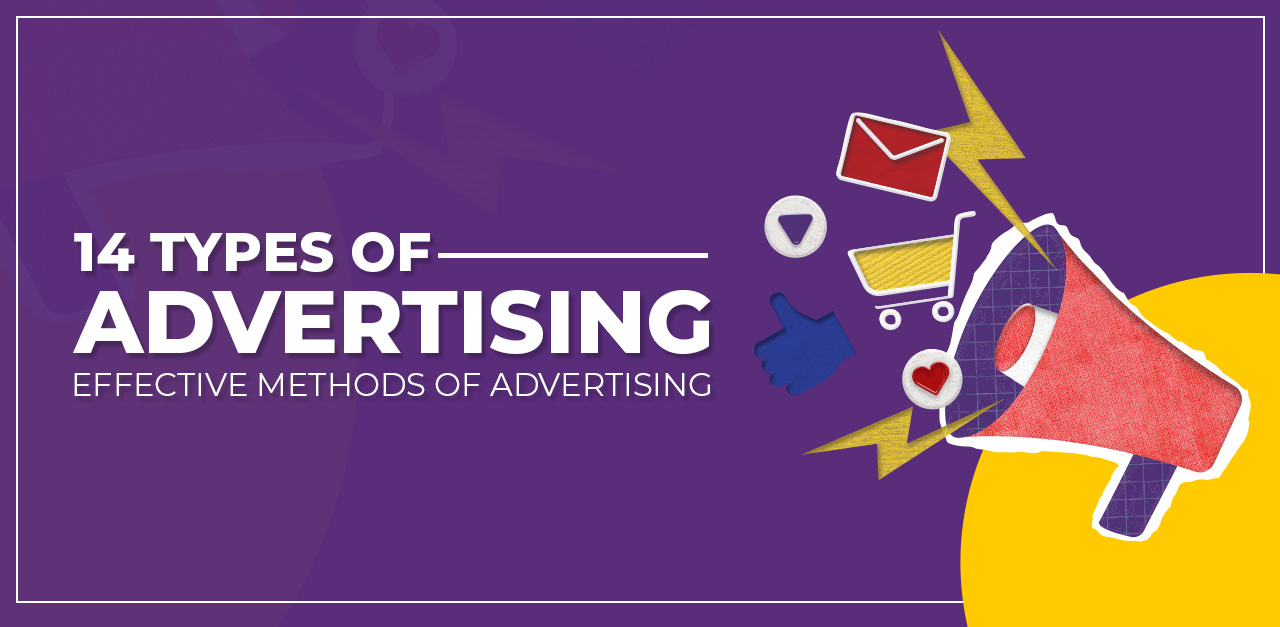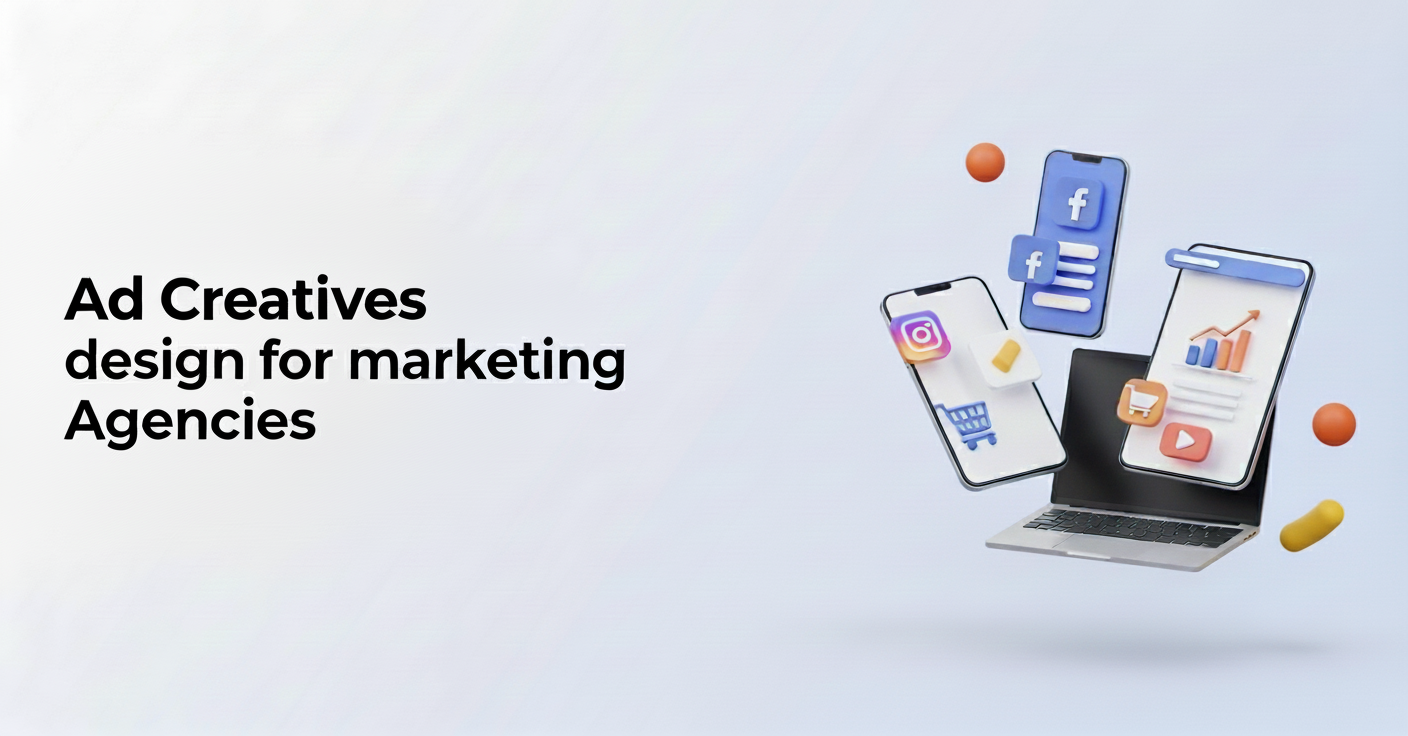Ever found yourself in the middle of a YouTube video and suddenly there is an advertisement for Maybelline lip stick or the newest Ford SUV? this is what advertising looks like, and advertising is everywhere.
In a fast-paced world, businesses need more than just a good product, they need clever ways to communicate to the right audience at the right moment. From television and radio spots, to online ads seen through various platforms (social media, search engines) knowing the advertising options will determine your success or failure with a campaign.
Similarly, you might see advertisements on Instagram that appear as you scroll through the platform, urging you to click or swipe up.
These ads help companies inform people about their products or services, but advertising is more than just telling; it’s persuading. It’s making people want or need something.
In this blog we will cover 14 powerful types of advertising, explore its use and how that type can be refined to meet specific business objectives and connect with audiences more efficiently. Let’s take a closer look at advertising
What is Advertising
Advertising is all about promoting a product, service or idea to the right people – encouraging them to take action, whether that’s purchase, sign up, or simply support. It is about creating a message, and sharing them through the right channels , to grab attention, create awareness and influence action.
In most cases, you’ll pay advertisers to ensure that your product is seen by their audience. This can happen in a newspaper, on a website, on a billboard, through a mobile app, or anywhere else that people consume information.
Advertising is not new for most people, still, advertisers continue to use it to influence people’s decisions.
Marketing vs. Advertising
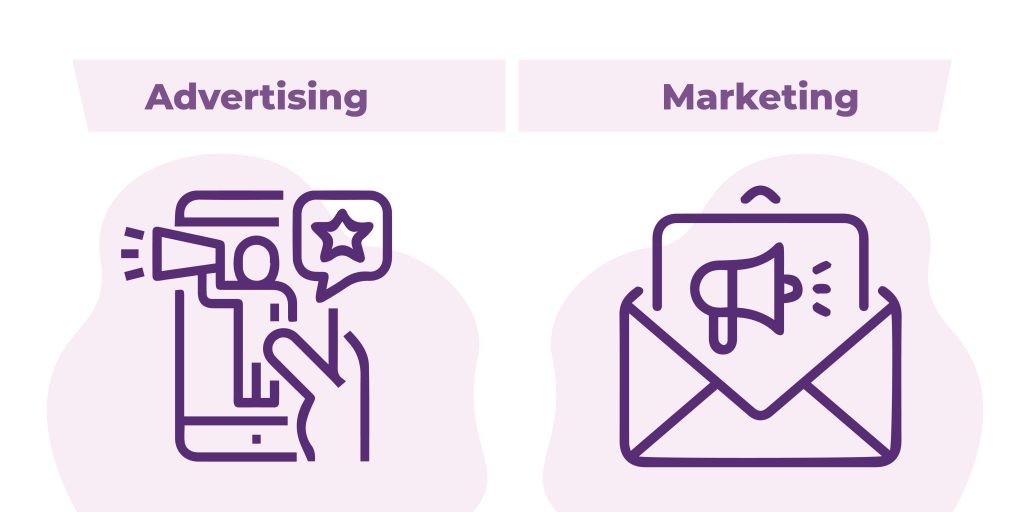
These both aim to promote products and services to consumers, but they’re not the same.
Marketing is a broader process that includes understanding customer needs, creating the right products, and then promoting them.
Advertising is just one part of marketing. It’s specifically about creating ads to tell people about these products and services.
Understanding both helps businesses reach their customers more effectively.
| Comparison based on | Advertising | Marketing |
| What it means | Advertising is a specific component of market communication where a company aims to draw public attention to a particular message, usually about its products or services. It’s about crafting compelling messages and placing them in various media to catch the eye of the audience. | Marketing is the comprehensive process of understanding market dynamics and consumer needs, to develop products that effectively sell themselves. This involves not only product development but also market research, pricing strategies, distribution, and more. |
| The purpose | Focused on achieving immediate responses and quick sales through compelling messages. | A broader goal, aimed at building long-term relationships and awareness around a brand. |
| How does it work? | Involves placing ads across various media platforms like TV, radio, newspapers, and social media. | Encompasses a range of activities beyond advertising, including research, product development, and strategy. |
| Approach | Short-term, designed to meet immediate sales goals. | Long-term, focused on building brand presence and customer relationships. |
| Objectives | Aims to create a market for products and maintain a brand image. | Broader focus on educating and engaging the market, covering the entire product journey. |
| Facilitates | Directly tied to sales generation, converting interest into purchases. | Facilitates awareness and understanding, fostering engagement rather than just sales. |
| Organised by | Managed by media platforms where the ads are placed | Managed by the business, covering all aspects from product development to customer interaction. |
Traditional vs. Present Day Advertising
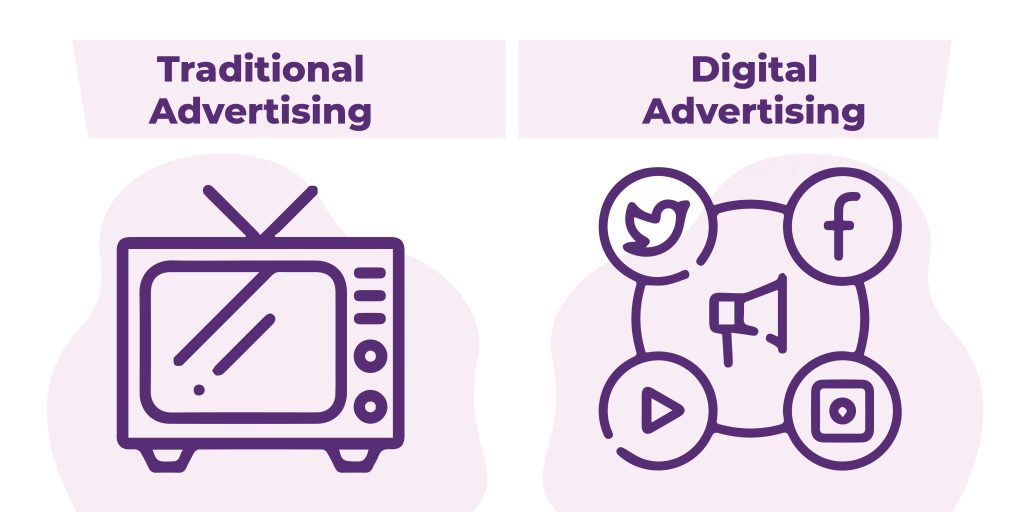
Traditional advertising and digital advertising are constantly at odds, and it’s all about finding which method is best for your business.
Let’s take a look at these two advertising worlds and compare and understand them.
| Comparison based on | Traditional Advertising | Digital Advertising |
| Nature | Traditional advertising is static and unchangeable. | Digital advertising is dynamic and interactive. |
| Conversion | Traditional advertising has slower conversion rates. | Digital advertising drives faster conversion rates. |
| Engagement | Engagement levels are lower in traditional advertising. | Digital advertising fosters higher engagement through interaction. |
| Return on Investment (ROI) | Measuring ROI in traditional advertising is challenging. | Digital advertising enables precise ROI tracking. |
| Effectiveness and Cost | Traditional advertising is costly and less effective. | Digital advertising is cost-effective and efficient. |
| Monitor | Tracking traditional ads’ effectiveness is challenging. | Digital advertising offers detailed tracking and analytics. |
| Target | Traditional advertising targets broad demographics. | Digital advertising offers personalized targeting options. |
| Refinement | Traditional ads cannot be altered. | Digital ads can be adjusted anytime. |
| Reach | The reach is usually local or regional. | Digital advertising enables global brand reach. |
| Results | Traditional advertising yields slower results. | Digital advertising offers real-time results. |
| Interruptions | Traditional ads can feel interruptive. | Digital ads can be skipped or blocked. |
| Communication | Traditional advertising is mostly one-way communication, where the audience cannot interact with the ad. | Digital advertising often enables two-way communication |
Types of Advertising
The main types of advertising include traditional methods such as print (newspapers and magazines), broadcast (TV and radio), and outdoor (billboards) as well as digital formats like search engine ads, social media, video, and native advertising.
Digital advertising covers search engine ads, social media campaigns, display banners, video ads, and mobile promotions. Other notable types include direct mail, product placements in media, and the growing trend of influencer marketing.
Traditional advertising includes methods like print ads, TV and radio commercials, and outdoor advertising such as billboards.
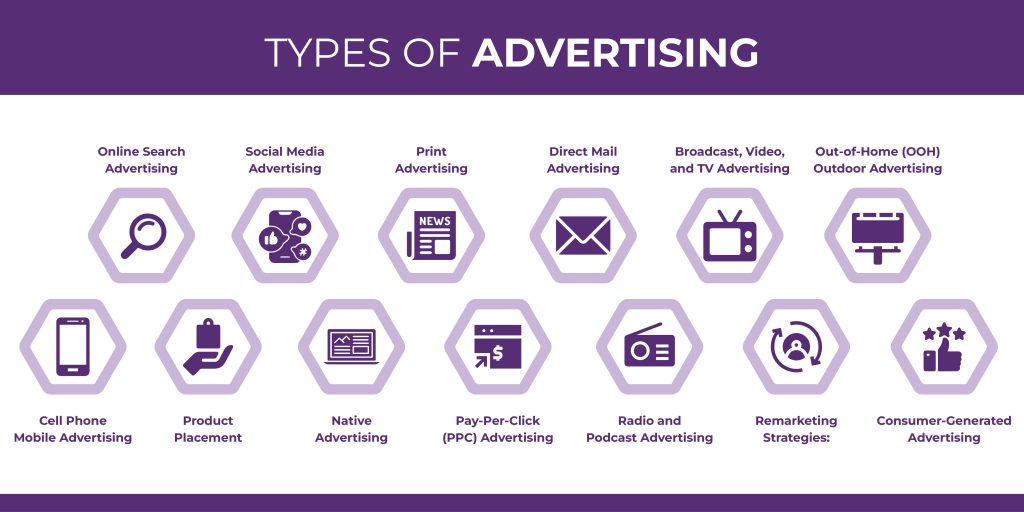
Online Search Advertising
This is a digital form of advertising where businesses pay to have their ads displayed on search engine result pages, like Google or Bing. When you search for something, the top results often include these ads, which are related to the keywords you’ve typed in. It’s a powerful way to capture the attention of potential customers who are already interested in what you’re offering.
Social Media Advertising
Social media platforms like Facebook, Instagram, Twitter, and LinkedIn offer targeted advertising options.
These ads can be tailored to appear in the feeds of users based on their interests, activities, and demographics. It’s a great way to engage with customers where they spend a lot of their time online.
Interested in making your Ad stand out and appear more creative on users’ newsfeeds? Subscribe to Designshifu. Enhance your brand with Design Shifu‘s limitless creativity!
You’ll get professional quality at a flat rate, rapid turnaround and unlimited revisions.
With our graphic design service, you’ll own your designs with full rights. Join us now and enjoy efficient, versatile, and customized design.
Print Advertising
This traditional form includes ads in newspapers, magazines, flyers, brochures, and other printed materials. It’s still effective, especially for reaching local markets or specific demographics that prefer physical media.
Direct Mail Advertising
Here, companies send promotional materials directly to people’s mailboxes. This can range from postcards and brochures to catalogs and samples. It’s a direct approach and can be personalized, making it effective for local businesses or niche markets.
Broadcast, Video, and TV Advertising
These ads appear on television or through online video platforms. They can range from traditional TV commercials to shorter video ads on platforms like YouTube. This type of advertising is great for reaching a broad audience and can be very engaging through visual and audio elements.
Out-of-Home (OOH) Outdoor Advertising
This includes billboards, bus stop posters, and digital signage you see in public spaces. It’s advertising that reaches people when they’re outside their homes. It’s great for high-visibility branding and reaching people in specific locations.
Cell Phone Mobile Advertising
Ads that appear on mobile devices, including smartphones and tablets, fall under this category. These can be banner ads in apps, text messages, or ads within mobile games. With the widespread use of mobile devices, this type of advertising is increasingly important.
Product Placement
Product placement quietly embeds products within films, television programs, and internet videos, becoming a part of the context or narrative. This approach supports products organically, without explicit advertising. It increases brand recognition by linking products with popular content, heightening attractiveness.
Native Advertising
Native advertising seamlessly integrates with the content with which it’s served, usually on online publications or social media. The ads look and feel exactly like the platform, like sponsored posts or articles that read just like regular content. The goal is subtlety so that the ads maximize user experience without disrupting it.
Display Advertising
Display advertising encompasses the visual ads we see on websites. These can take various forms, including banners at the top of a webpage, sidebars, or even pop-up ads. Display ads are versatile and can include text, images, video, and more.
They’re great for creating brand awareness and can be highly targeted to specific audiences based on their online behavior, interests, and demographics. The visual nature of these ads makes them stand out, helping to capture the attention of potential customers.
Want to stand out in the crowded online space?
Let Design Shifu boost your display advertising with engaging banners, engaging sidebars, and memorable pop-up ads. We bring unlimited creative potential to your campaign.
Benefit from our swift turnaround, unlimited revisions, and full design ownership at a flat rate. Increase your brand’s visibility with Design Shifu’s professional, custom designs, perfectly crafted to grab your audience’s attention.
Subscribe now and transform your display ads into compelling visual stories!”
Pay-Per-Click (PPC) Advertising
PPC advertising is a system where the advertisers pay per click of their advertisement, purchasing visits rather than earning them naturally. It is widely used in search engine ads such as Google AdWords. When implemented correctly, PPC targets users who are actively looking for products or services that are relevant to the advertiser.
Radio and Podcast Advertising
Radio and podcast advertising successfully addresses specific audience segments. In radio, advertisements are inserted between music or talk segments, whereas podcast advertisements are read by the host, providing a personal touch. This method enables advertisers to reach niche audiences according to content interests.
Remarketing Strategies
Remarketing involves targeting visitors to your site or app by presenting them with ads on other websites. It reminds them that they were interested in your service or product previously. It is effective because it targets users already aware of your brand, so it prompts further action.
Consumer-Generated Advertising
Consumer-generated advertising enables customers to generate and distribute content related to a product or brand. It can take place organically on social networks or through systematic campaigns such as contests. It is an effective approach because of its genuineness, making it appealing and convincing to potential customers.
Advertising Best Practices To Stay Ahead of Your Competition
Identify Your Target Audience
The foundation of effective advertising is a deep understanding of your target audience. This includes knowing their demographics, interests, behaviors, and preferences. Tailoring your advertising strategy to resonate with your audience’s needs and desires significantly increases its effectiveness.
Create An Engaging Message
Your ad’s message is crucial. It should be clear, concise, and engaging, with a strong call to action. A compelling message not only informs the audience about your product or service but also evokes emotions and encourages them to take a specific action, like making a purchase or visiting your website.
Channel Selection
Different advertising channels have different strengths and cater to different audiences. Choosing the right mix of channels – whether it’s social media, search engines, traditional media, or any other – is key to reaching your target audience effectively.
The choice should align with where your audience spends their time and how they consume content.
Utilize Data and Analytics
Data-driven advertising allows for more targeted and personalized campaigns. Utilizing data and analytics helps in understanding audience behavior, preferences, and trends. This insight guides the optimization of your campaigns for better performance and ROI.
Visually Appealing Content
In a world filled with advertising noise, visually appealing content can make your ads stand out. This includes the use of high-quality images, engaging videos, attractive graphics, and a coherent color scheme that aligns with your brand.
Ensure Message Consistency Across Platforms
Consistency in messaging across various platforms reinforces your brand and its message. Whether a customer sees your ad on social media, a billboard, or a TV commercial, the core message should be unified. This helps in building a strong, recognizable brand.
Leverage Social Media Effectively
Social media platforms are powerful tools for advertising. They offer precise targeting options and the ability to engage directly with your audience.
Leveraging these platforms effectively involves creating content that resonates with your audience, engaging with them, and utilizing the platforms’ unique advertising features.
Focus on Mobile-First Strategies
With the increasing use of mobile devices, adopting a mobile-first approach in your advertising strategy is crucial. This means optimizing all your online content for mobile devices, ensuring that your ads are effective and engaging on smaller screens.
Measure and Analyze Campaign Performance
Regularly measuring and analyzing your campaign performance is vital for understanding its effectiveness.
This involves tracking metrics like click-through rates, conversion rates, engagement levels, and ROI. Analysis helps in identifying what works and what doesn’t, allowing for continuous improvement.
Stay Up-to-Date with Advertising Trends
The advertising world is constantly evolving with new technologies, platforms, and consumer behaviors. Staying up-to-date with these trends and adapting your strategies accordingly is crucial for staying relevant and effective in your advertising efforts.
Frequently Asked Questions
What Are The 3 Main Types Of Ads?
Print Advertising: This includes ads in newspapers, magazines, flyers, and brochures. It’s one of the oldest forms of advertising.
Broadcast Advertising: This covers ads on television and radio. These ads reach a wide audience and can be very effective due to their audio-visual nature.
Digital Advertising: This encompasses a range of online ads, like those on websites, social media, and search engines. It’s the most versatile and customizable type of advertising.
What Is The Most Common Type Of Advertising?
Currently, Digital Advertising is the most common type. This is because of the widespread use of the internet and the rise of social media.
Digital ads can be targeted very specifically to the audience and are often more cost-effective than traditional advertising methods.
How can Advertising Work for My Business?
Advertising can help your business by increasing brand awareness, attracting new customers, and boosting sales. By targeting your ads to the right audience and using the right message, you can effectively communicate the value of your products or services.
It also helps in distinguishing your business from competitors and building customer loyalty over time.
What Is The Role Of Advertising Media?
The role of advertising media is to provide a platform for businesses to communicate their messages to their target audience. This can be through various channels like TV, radio, print, and online platforms.
Advertising media helps in reaching a wide audience, allows for creative presentation of messages, and supports the tracking and measurement of advertising effectiveness.
Is Direct Mail Advertising Outdated?
Direct Mail Advertising is not necessarily outdated; it just serves a different purpose now. While digital advertising has become more prevalent, direct mail still has its place, especially for reaching local markets or specific demographic groups who respond better to physical mail.
It can be particularly effective when personalized and used as part of an integrated marketing strategy that includes both digital and traditional methods.

